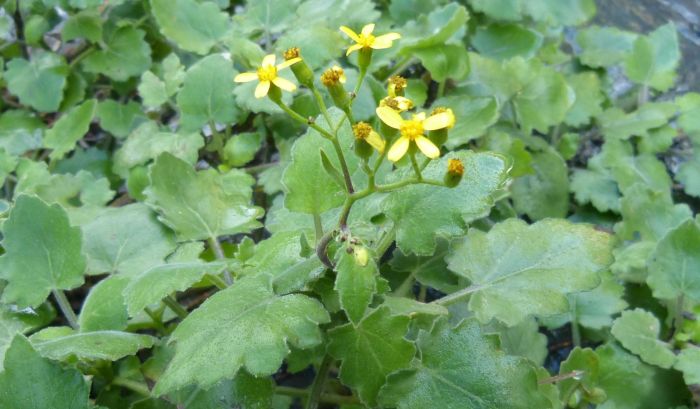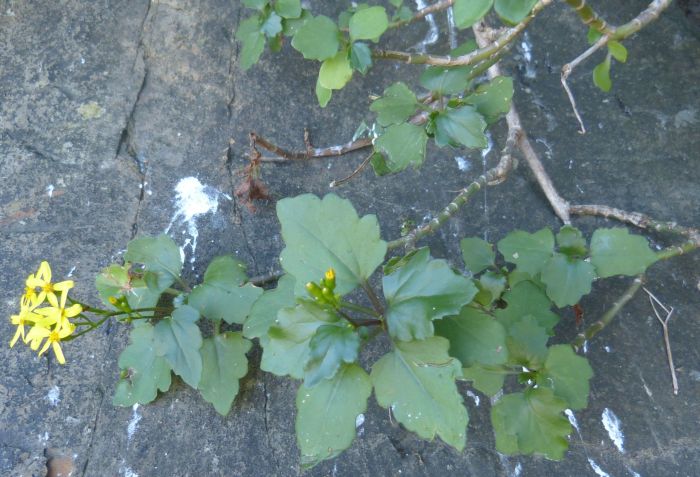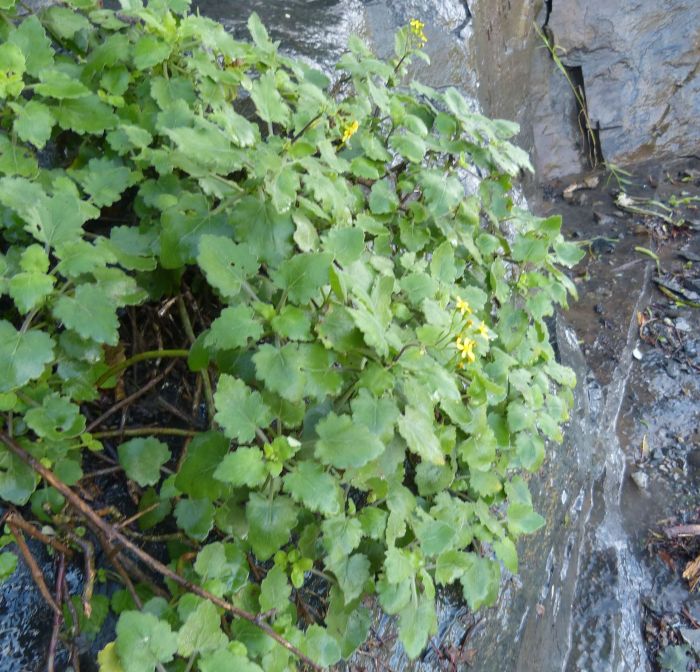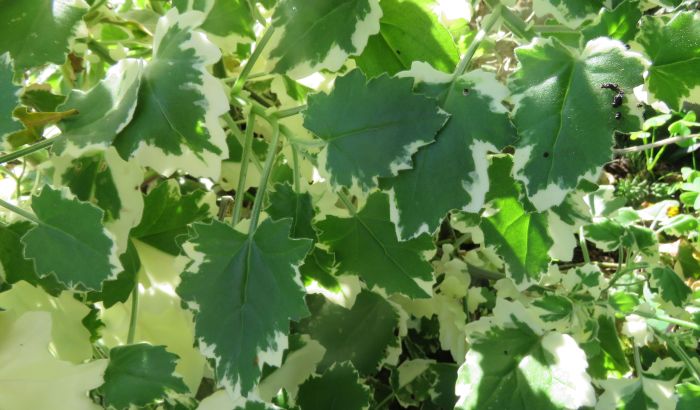Senecio voigtii
Senecio voigtii Van Jaarsv.
Family: Asteraceae
Common names: Voigt’s senecio
Introduction
Senecio voigtii is an attractive, multi-stemmed shrublet, 300-600 mm tall, from the dry river valleys in the Eastern Cape. It is immediately recognized by its triangular, semi-succulent, irregularly toothed leaves, superficially resembling a species of Plectranthus. It has smooth to sparingly hairy leaves and ascending corymbs of yellow flowers. The cultivar Senecio voigtii ‘Ezra’ is a variegated selection from the Kei River discovered by Werner Voigt and named for his son Ezra. They grow well in cultivation and the variegated cultivar has become a popular garden ornamental.

Figure 1. Senecio voigtii growing along the Mbashe River, Eastern Cape.
Description
Description
Rapid-growing, branched, evergreen, ascending shrublets or shrubs 300–600 mm high. The roots are fibrous. The stems are succulent, rounded (terete), 5–7 mm diameter, sparingly hairy (pilose) at first becoming smooth or hairless (glabrescent), green, becoming purplish. The leaves are ascending, spreading, alternately arranged, succulent, triangular to triangular-egg shaped, often bearing a little ear-shaped to 3-lobed leaf-like stipule at the base of the petiole. The leaf stalk is 22–55 mm long, the upper surface flat to slightly channelled; the lower surface rounded, with fine hairs (pilose). The leaf blade 35–65 × 25–50 mm the base varies from truncate, to almost heart-shaped (hastate to subcordate). The leaf margin is irregularly dentate, the teeth often with smaller teeth (duplicato-serratus), the leaf tip (apex) is acute. The leaf surface is sparingly hairy (pilose) and more so on the veins.

Figure 2. Senecio voigtii illustration by Marieta Visagie. The variegated portion is the cultivar ‘Ezra’.
The branched inflorescence is 200–300 mm tall (corymbose), bearing more or less 8–15 radiate flower heads. The flower heads (capitula) 7–8 × 2.5 mm, about 24 mm in diameter. The ray florets spreading, recurved, yellow, oblong, 10 × 3–4 mm and the disc florets tubular, 5 mm long. Senecio voigtii flowers in autumn and winter, the seeds are released in spring. In cultivation, it can flower at almost any time of the year.

Figure 3. Senecio voigtii growing on a shale cliff in Valley Bushveld at the Nahoon Dam, Eastern Cape.
Conservation Status
Status
Senecio voigtii has not been assessed for the Red List of South African Plants, but it is fairly common and is distributed over a wide area and consequently it is not considered to be threatened.

Figure 4. Senecio voigtii along the Mbashe River, Eastern Cape.
Distribution and habitat
Distribution description
Senecio voigtii has a fairly wide distribution but is confined to the dry river valleys of the Eastern Cape and southern KwaZulu-Natal. It can be found from Mtamvuna River in southern KwaZulu-Natal to the Keiskamma River near East London in the Eastern Cape. The vegetation consists of Eastern Valley Bushveld (Sub-Escarpment Savanna Bioregion) which is part of the Savanna Biome (Mucina et al. 2006). These river valleys have a fairly dry climate, which is intensified by the steep slopes, and consequently, during periods of rain there is a high run off. It grows in places covered with thickets and semi-deciduous woodlands that are rich in succulent plants.

Figure 5. The habitat of Senecio voigtii, along the Kei River, Dave Gwynne-Evans taking a photo and Adam Harrower behind rock. (Photo Werner Voigt)
Senecio voigtii grows on steep rocky embankments and cliffs. It is most often found in partial shade on south facing slopes. The climate here is subtropical, hot in the summers but cooler in winters, and frost is absent. Rainfall is experienced mainly in the summer months and is often associated with thunder showers. Some rainfall may occur in winter as a result of cold fronts from the west. Rainfall ranges from 600 to about 800 mm per annum. The geology consists mainly of sedimentary rocks, such as shales of the Karoo Supergroup, but in the northern part, also mineral poor quarzitic sandstone of the Natal Group (Keyser 1997).

Figure 6. The Kei River in the Eastern Cape, habitat of Senecio voigtii.
Along the lower Kei River, Senecio voigtii was found on rocky steep shale slopes and cliff ledges sharing their habitat with various other drought-adapted plants such as Bauhinia bowkerii, Encephalartos altensteinii, Commiphora harveyi and Ficus burtt-davyi. Associated succulent plants include Aloe pluridens, Aptenia cordifolia, Delosperma tradescantioides, Plectranthus madagascariensis, Cotyledon pendens, Fockea edulis, Chlorophytum comosum, Gasteria excelsa and Crassula multicava.
Derivation of name and historical aspects
History
Senecio voigtii was named in Flowering Plants of Africa in 2019 (Van Jaarsveld & Visagie 2019). It honours Werner Voigt, Curator of Kirstenbosch National Botanical Garden (former Curator of the Karoo National Botanical Garden and Harold Porter National Botanical Garden). Werner has assisted the author on several rubber boat expeditions to the Eastern Cape, exploring and collecting plants from regions that are botanically poorly known and difficult to reach by foot or vehicle. He is also responsible for collecting, on our Kei River expedition, a natural variegated mutant, of S. voigtii (Voigt 642, 14 April 2013 38/2013, NBG) which he propagated and spread. This cultivar was also named in the 2019 publication and honours his son Ezra Voigt, who was healed from Leukaemia in 2017. Werner is an ambassador for South Africa’s succulent plants, promoting them both in his collections and in the many lectures that he gives to various societies. The cultivar ‘Ezra’ has leaves with white and pink portions and has become popular in cultivation.

Figure 7. Werner Voigt (left) & Ricardo Riddles (right) in a rubber canoe on the Kei River. Werner, Curator of the Karoo National Botanical Garden at the time, discovered and collected the variegated sport.
The genus Senecio was established by Carl Linnaeus, the Swede who brought order to the naming of plants with his binominal system. More than 40 are succulent or semi-succulent. (Herman et al. 1997, Van Jaarsveld & Visagie 2015). The generic name Senecio is derived from Greek senex, meaning ‘old man’, and pertaining to the white hairs of the pappus resembling the beard of an old man (Clarke & Charters 2016).
Senecio voigtii belongs to Scandentes, a section of which 9 species occur in South Africa (Harvey 1894). Of these, Senecio angulatus L.f., S. tamoides DC., S. bryoniifolius Haw. and S. macroglossus DC. are succulent and frequently cultivated in South Africa and abroad. Senecio voigtii comes closest to S. angulatus, but is at once distinguished by being much smaller and not a scandent shrub. The leaves of S. voigtii are also truncate to cordate at the base and sparingly hairy. The base of the leaf stalk has a little ear immediately separating it from S. angulatus. Senecio angulatus is a much larger scandent shrub with hairless leaves. The two species often share the same habitat (are sympatric).
Ecology
Ecology
The succulent nature of Senecio voigtii enables it to survive periods of drought, which are so often experienced in South Africa. The exclusive dry river valleys and cliffs habitat ensures the plants long-term survival. Even when the plant is trampled or grazed, parts which fall to the ground will root and form a new plant, this is so typical of many of the succulent and semi-succulent plants from the Eastern Cape. Passive resistance is the secret of their long term survival, a strategy enabling the plant to take advantage of animal disturbances so often associated with succulents of the savanna and thicket vegetation of this region. Instead of succumbing when trampled or grazed, parts of the stems are able to root, ensuring its survival and also acts as a vegetative cloning back-up. This is also the reason why so many semi-succulent plants from the Eastern Cape perform so well in gardens.
The yellow flowers are pollinated by insects and the seed is wind dispersed. Superficially in its habitat the plant resembles a member of the genus Plectranthus (Lamiaceae).
Uses
Use
It is not known whether the plants are used medicinally.

Figure 8. Senecio voigtii ‘Ezra’ with its decorative variegated leaves.
Growing Senecio voigtii
Grow
Senecio voigtii grows well in cultivation and is best suited for Mediterranean, bushveld and subtropical gardens. It is best grown along the shady southern sides of buildings or walls where it is protected from the hot afternoon sun. Plants can be planted about 50 cm apart. Cuttings can be placed in situ directly into the beds from spring to autumn, and when well-watered will rapidly root and grow. Once established the plant should be self-sustainable and thus the ideal water-wise garden plant. It should also flower within the season of planting. Prune back two thirds during winter months to ensure a neat growth. The plant responds well to fertiliser. The cultivar ‘Ezra’ has variegated leaves, and has become well established in cultivation. Senecio voigtii also grows and performs well in containers.
Propagation is best from cuttings. Cutting of about 10 cm length or longer should be used. Remove lower leaves and plant is sand or peat or a sterile growth medium in a tray or suitable container. Keep moist, place in a shady or light shady corner. Rooting is rapid during the warmer part of the year. Once rooted the plants can be transferred to containers or directly to the garden.
References
- Christenhusz, M.J.M., Fay, M.F. & Chase, M.W. 2017. Plants of the World, an illustrated Encyclopedia of vascular plants. Kew Publishing, Royal Botanic Gardens, Kew.
- Clarke, H. & Charters, M. 2016. The illustrated dictionary of southern African plant names. Flora & Fauna Publications Trust, Jacana, Johannesburg.
- Harvey, W.H. 1894. In Flora Capensis. Vol. 3; 402-405. Compositae. L. Reeve & Co., Ltd. The Oast House Brook, near Ashford, Kent (U.K.).
- Smith, G.F., Van Jaarsveld, E.J., Arnold, T.H., Steffens, F.E., Dixon, D. & Retief, J.A. (eds) 1997. List of southern African succulent plants: 1–175. Umdaus, Hatfield, Pretoria.
- Keyser, N. 1997. Geological Map of the Republic of South Africa and the Kingdoms of Lesotho and Swaziland. Council for Geoscience, Pretoria.
- Koekemoer, M., Steyn, H.M. & Bester, S.P. 2015. Guide to Plant Families of southern Africa. Strelitzia 31. 2nd ed., 2nd print. South African National Biodiversity Institute, Pretoria, South Africa.
- Mucina, L. & Rutherford, M.C. (eds) 2006. The vegetation of South Africa, Lesotho and Swaziland. Strelitzia 19. South African National Biodiversity Institute, Pretoria.
- Funk, V.A., Susanna, A., Stuessy, T.F. & Bayer, R.J. (eds). 2009. Systematics, Evolution, and Biogeography of Compositae. International Association for Plant taxonomy, Vienna.
- Rowley, G.D. 1994. Succulent compositae. A grower’s guide to the succulent species of Senecio & Othonna. Strawberry Press, California.
- Van Jaarsveld, E.J. 2010. Water wise gardening. Struik, Cape Town.
- Van Jaarsveld, E.J. 2019. Senecio voigtii. Flowering Plants of Africa. 66, Plate 2359, 160-167.
Credits
Ernst van Jaarsveld
Kirstenbosch National Botanical Garden (Retired 2015)
Babylonstoren Farm
Extraordinary senior lecturer and researcher,
Department of Biodiversity and Conservation, University of the Western Cape
February 2020
Plant Attributes:
Plant Type: Ground Cover, Shrub, Succulent
SA Distribution: Eastern Cape, KwaZulu-Natal
Soil type: Sandy, Loam
Flowering season: Autumn, Winter, Sporadic/All year
PH: Acid, Neutral
Flower colour: Yellow
Aspect: Shade, Morning Sun (Semi Shade), Afternoon Sun (Semi Shade)
Gardening skill: Easy
Special Features:
Horticultural zones










Rate this article
Article well written and informative
Rate this plant
Is this an interesting plant?
Login to add your Comment
Back to topNot registered yet? Click here to register.